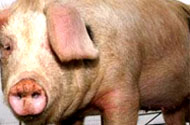Danish scientists make tool to spot weak sows

Danish scientists from Aarhus University’s Faculty of Agricultural Sciences have developed a tool that eases the task of identifying weak sows. Recognising these also becomes safer and more systematic.
The scientific project is about the development of an index that can identify weak sows, i.e. sows that are not expected to stay the course.©
Head of research unit Jan Tind Sørensen, Department of Animal Health and Bioscience at the Faculty of Agricultural Sciences, explained: ”We provide farmers with a tool that helps him observe his animals in a systematic manner and to treat the observations to an index. Firstly, the assessments take place at certain times; secondly, they follow a protocol for short, systematic, clinical examinations of the individual sows in the farrowing or gestation pens, and, thirdly, they are converted into an index.”
Sørensen has been the leader of the project that has collaborated closely with KU-Life and an advisory group with representatives from the Swine Information Centre.
Weak sows are more exposed
When the scientists started the project, their hypothesis was that a weak sow is a sow with several clinical signs that combined means she is at risk of being slaughtered early, dying or being euthanised.
After extensive assessments of 36 herds of sows, the hypothesis turns out to hold true. Weak sows have an increased risk of being slaughtered early due to disease or being sent for destruction.
Through the clinical examinations in the farrowing and gestation stalls in the 36 herds, the scientists have found a number of characteristics that are both easy to observe and that are determinants for whether the sow can be defined as weak.
Causes of death
”We structured our data into 16 causes, ten of which could be related to three factors directly linked to culling or disease,” Sørensen said.
”The analyses show that the main factors are lameness and willingness to stand as well as bites on the vulva for pregnant sows, and lesions, body condition and vulva colour for lactating sows. The factors are weighted and included in an index that can be used directly on the farm.”
Future perspectives
The project is now in its final stage that includes an analysis of risk factors that code for a high prevalence of weak sows in individual herds so the scientists can define preventative measures. They are also calculating the effect on production of a high weak-sow index.
Sørensen added, ”We see good future perspectives in continuing research into actual applications of the weak-sow index. Among other things, we would like to look at how the economy, mortality, production and reproduction are affected if you put the weak sows into relief pens. We plan to carry out this part of the study on private pig farms, because you need a large number of animals and real production conditions to ensure reliable and relevant data.”
He expects positive outcomes from the index. ”We would also like to contribute to the development of personal PDA and computer solutions that can aid the practical application of the weak-sow index on farms.”©©
The project is supported by the Danish Pig Levy Foundation.
Related website:
• Aarhus University, Faculty of Agricultural Sciences











